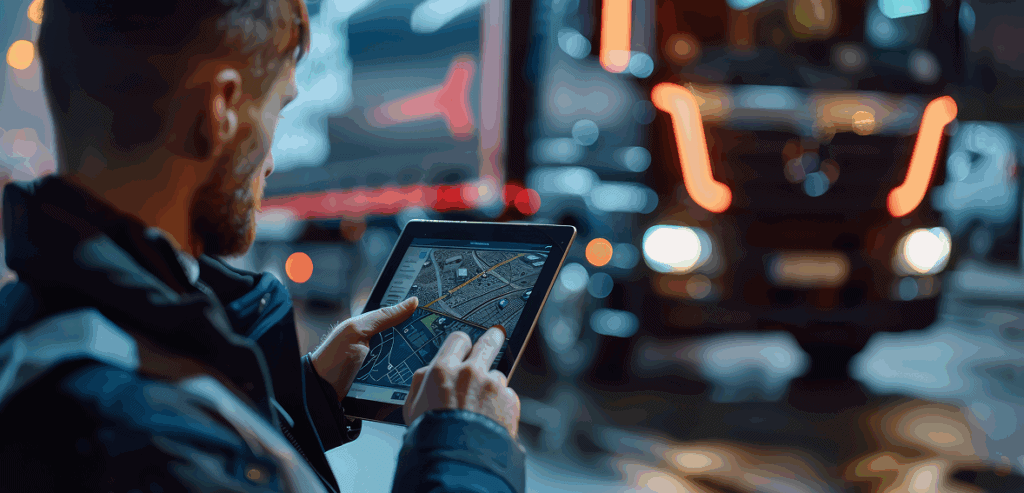
By Sophia Briggs July 21, 2025
The limousine industry has always been associated with luxury, elegance, and exclusive service. However, what many passengers do not see is the intricate web of operations, logistics, and coordination that happens behind the scenes. Traditionally, much of this work was manual, relying heavily on paper-based systems, radio dispatch, and phone bookings. But times have changed.
Technology is quietly transforming the limo business in powerful ways. From booking automation and fleet tracking to customer service enhancements and data-driven decision-making, the shift toward digital tools is not just improving efficiency but redefining what it means to offer premium ground transportation.
The Digital Shift in Limo Booking Systems
One of the most visible changes in the limo industry has been the transition from manual to digital booking systems. Not long ago, most limousine services relied on phone calls and handwritten notes to manage reservations. This approach often led to missed bookings, over-scheduling, or human error.
Modern booking software now allows customers to schedule rides online or through mobile apps. These platforms offer real-time availability, instant pricing, and automated confirmations. For businesses, the system reduces administrative workload and provides a clear overview of upcoming trips.
Back-end systems now integrate with calendars, flight trackers, and even CRM software, ensuring each booking is accurate and timely. With these tools, limo companies can manage dozens or even hundreds of rides a day without losing control or compromising service quality.
Dispatch and Driver Management in Real Time
Dispatch used to involve two-way radios, clipboards, and lots of manual coordination. Today, technology enables real-time dispatching through cloud-based platforms. These tools allow dispatchers to assign jobs, track vehicle location, and communicate with drivers instantly using smartphones or tablets.
For limo companies, this means greater flexibility and fewer errors. If a driver is running late, dispatch can reroute another vehicle or notify the client in seconds. If a new job comes in last minute, it can be assigned with a few clicks.
GPS tracking helps monitor driver behavior, manage fuel use, and improve on-time performance. It also allows companies to provide accurate ETAs to customers, enhancing trust and satisfaction. These systems work behind the scenes to keep operations running smoothly, no matter how busy the day gets.
Fleet Optimization with Telematics and Maintenance Tools

Managing a limousine fleet involves more than just scheduling. Each vehicle requires maintenance, fueling, insurance, inspections, and timely replacements. Technology is making this easier by offering telematics and fleet management platforms that track vehicle health in real time.
These systems monitor engine performance, tire pressure, oil levels, and service schedules. They can alert managers before a vehicle breaks down or falls behind on maintenance. As a result, companies avoid costly repairs and reduce downtime.
Some platforms also calculate the total cost of ownership for each vehicle, helping companies make smarter decisions about when to replace or upgrade. Fuel usage reports, mileage tracking, and driver behavior logs contribute to more efficient operations and longer vehicle life.
Mobile Apps for Drivers and Staff
In today’s fast-moving environment, drivers need more than a phone and a GPS. Many limousine companies now provide mobile apps that offer everything from job details and navigation to shift schedules and customer preferences.
These apps help drivers stay organized, manage their time, and communicate with dispatchers easily. They can access real-time updates, view upcoming trips, and send arrival alerts to passengers. For companies, the apps ensure consistency and accountability.
Staff beyond the driver team also benefit from mobile technology. Operations managers, customer service agents, and maintenance crews can use mobile dashboards to track workflows, manage client interactions, and resolve issues from anywhere.
Mobile tools have become the backbone of limo businesses looking to stay competitive and connected.
Customer Experience Enhanced by Technology
Luxury transportation is all about experience. Technology is playing a growing role in how that experience is delivered. Today’s clients expect digital convenience to match the physical luxury of a limo ride.
Online booking, real-time updates, digital receipts, and mobile apps all contribute to a seamless customer journey. Passengers can track their ride, receive notifications, and pay without touching a credit card or signing a paper receipt.
CRM tools are also changing the game. Companies now track customer preferences, special requests, and travel history to deliver personalized service. This level of attention makes clients feel valued and more likely to return.
By automating repetitive tasks and streamlining communication, technology allows staff to focus on what matters most—delivering a memorable, stress-free ride.
Integrated Payment and Billing Systems
Managing payments and billing manually can be a major time drain, especially for companies with large fleets or high booking volumes. Technology has introduced integrated payment systems that allow for faster, more accurate invoicing and collections.
These systems support one-click payments, recurring billing, and automated invoice generation. They also handle gratuities, promotions, and tax calculations. This streamlines operations and minimizes human error.
Some limo companies are using digital wallets, QR codes, and app-based payments to further modernize their financial systems. Clients appreciate the convenience, while staff save time and avoid confusion.
These integrated systems often sync with accounting software, making monthly reconciliation and financial reporting much easier.
Data Analytics for Smarter Decision-Making

Behind the scenes, data is playing a bigger role than ever in the limousine business. By tracking operations, client behavior, fleet performance, and financial trends, companies can make informed decisions about pricing, staffing, and service upgrades.
Analytics tools allow business owners to identify their most profitable routes, busiest times of day, and most frequent customers. They can also monitor driver efficiency, vehicle utilization, and cost per mile.
This insight leads to better marketing campaigns, smarter resource allocation, and proactive service improvements. Data-driven decision-making turns daily operations into strategic growth opportunities.
Companies that embrace analytics gain a competitive edge, using numbers to shape everything from pricing structures to fleet expansion plans.
Automation in Scheduling and Resource Allocation
Coordinating vehicles, drivers, and bookings can be a logistical challenge. Automation simplifies this process by matching demand with availability instantly.
Scheduling software can automatically assign drivers based on factors like location, experience, and availability. It can block off time for vehicle maintenance and reroute jobs if a vehicle becomes unavailable.
Automation also helps with follow-ups and client communication. Reminder emails, thank-you messages, and feedback requests can be scheduled in advance, keeping the client engaged without burdening the team.
With these systems in place, limo companies reduce errors, eliminate double bookings, and improve overall efficiency.
Enhancing Safety with Digital Tools
Safety has always been a top priority in the limousine industry, and technology is helping raise standards further. Driver background checks, license verification, and training compliance can now be managed digitally, ensuring that only qualified drivers are on the road.
In-vehicle safety tools like dash cams, lane-assist technology, and driver fatigue monitors help prevent accidents. Telematics systems can alert dispatchers if a driver is speeding or making sudden stops.
Contactless payment, digital receipts, and app-based communication also contribute to passenger safety by minimizing physical interaction.
Digital records of every trip, including timestamps, driver identity, and GPS logs, provide accountability and peace of mind for both the company and the client.
Environmental Impact and Green Fleet Management
Sustainability is becoming increasingly important for both companies and clients. Technology is helping limo services reduce their environmental impact through electric vehicle (EV) integration, route optimization, and fuel monitoring.
Fleet management platforms can help schedule the use of EVs on shorter routes or in urban areas. They also assist in tracking emissions, managing charging schedules, and calculating carbon footprints.
Eco-conscious clients appreciate transparency around sustainability efforts. Highlighting green initiatives through your website or app can be a differentiator in a competitive market.
By embracing green technology, limousine companies not only reduce costs but also build a future-ready brand.
Cloud-Based Solutions for Seamless Operations
Cloud computing has revolutionized business operations across industries, and the limo sector is no exception. Cloud-based platforms offer flexibility, scalability, and real-time access to important data from any device. Reservation management, customer databases, vehicle schedules, and billing systems can all live in the cloud. This ensures continuity even if the main office experiences technical issues or if staff work remotely.
Updates happen automatically, data is securely backed up, and new features can be added without complex installations. Cloud-based solutions enable limo companies to grow without being limited by infrastructure.
These tools allow for centralized management across multiple locations, making them ideal for companies looking to expand.
Adapting to Changing Customer Expectations
Customer expectations are changing rapidly, influenced by digital-first services in other sectors. The limousine industry must keep up to remain relevant and competitive.
Clients now expect online booking, instant confirmations, and detailed receipts. They want the ability to communicate via text or app, receive driver details in advance, and get loyalty rewards automatically.
Technology enables limo companies to meet these demands without hiring more staff or overhauling their entire process. Simple tools like client portals, chatbots, and feedback forms can enhance service without adding complexity.
By aligning with modern customer expectations, limo services stay top of mind for business travelers, event organizers, and high-end clients.
Future Outlook: Innovation Will Drive Differentiation
Looking ahead, the limo industry will continue to evolve as new technologies emerge. Artificial intelligence, predictive analytics, and voice-activated bookings are just the beginning.
Companies that invest in innovation will differentiate themselves through superior service, operational efficiency, and customer loyalty. Those who delay modernization may struggle to compete in a fast-changing market.
Technology is no longer a luxury. It is a necessity that powers everything from bookings to billing, from driver performance to customer satisfaction. Behind every smooth ride is a complex system made simple through digital tools.
Conclusion: Building a Smarter, Stronger Limo Business
The limousine business is undergoing a quiet revolution. While passengers enjoy the comfort and elegance of the ride, technology is working tirelessly in the background to ensure that every step is smooth, secure, and smart. From real-time dispatch and fleet management to automated scheduling, payment systems, and client engagement, digital tools are changing how limo companies operate. They help reduce costs, eliminate inefficiencies, and deliver experiences that clients remember for all the right reasons. To stay competitive and profitable, limousine businesses must embrace this wave of change. The future of the industry will be shaped by those who combine classic service with cutting-edge technology.